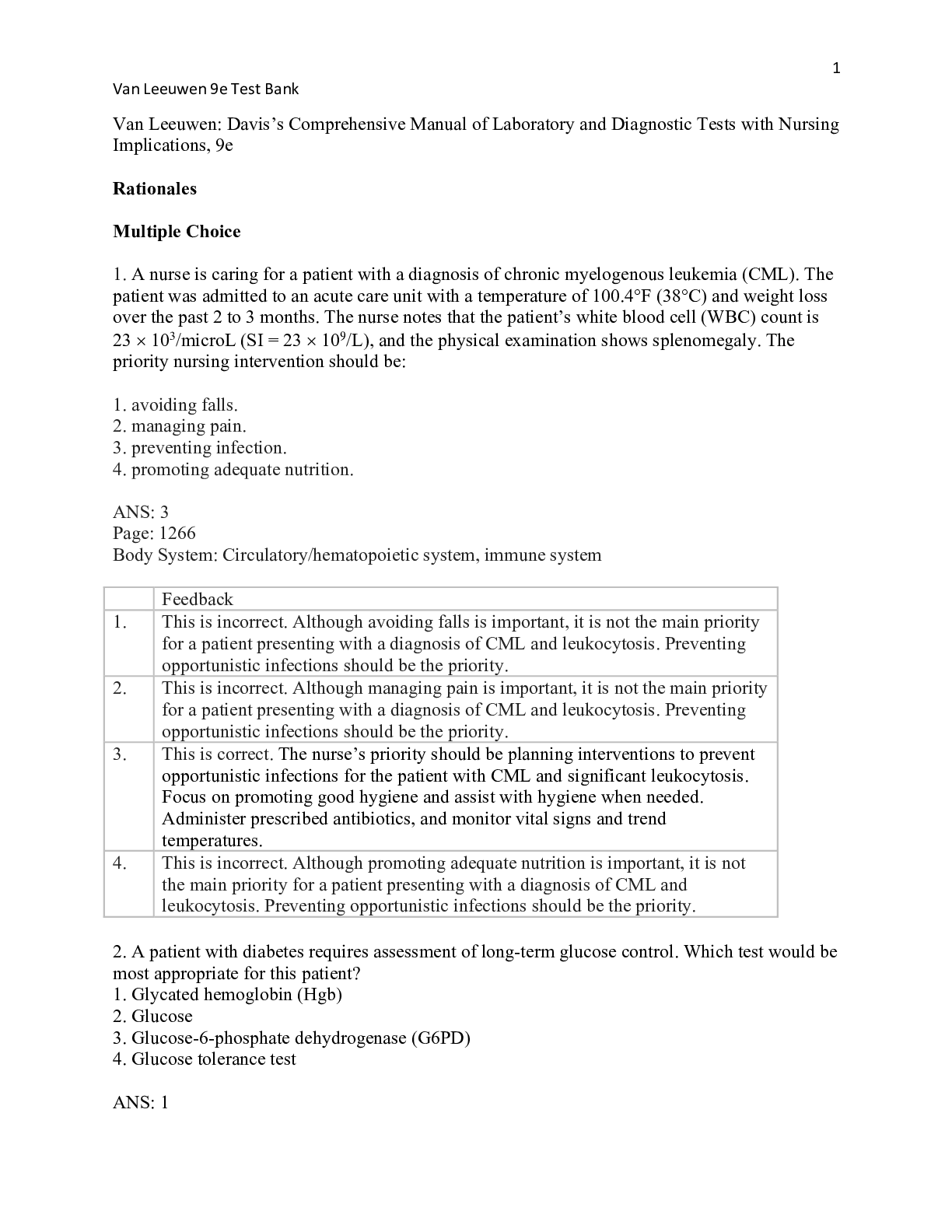*NURSING > TEST BANK > Test Bank: Laboratory and Diagnostic Meiner: Gerontologic Nursing, 6th Edition,100% CORRECT (All)
Test Bank: Laboratory and Diagnostic Meiner: Gerontologic Nursing, 6th Edition,100% CORRECT
Document Content and Description Below
Test Bank: Laboratory and Diagnostic Meiner: Gerontologic Nursing, 6th Edition MULTIPLE CHOICE 1. The leukocyte count of an older adult patient is elevated. Understanding the effects of aging ... on body functions, what action by the nurse is best? a. Check for drug allergies before requesting an antibiotic prescription. b. Take vital signs and perform a head to toe assessment. c. Encourage the patient to drink several glasses of water. d. Collect a urinalysis as soon as possible, having the patient produce a urine sample and requesting a stat urinalysis. ANS: B When interpreting laboratory values and deciding the best course of treatment, the older adult should be viewed holistically: signs, symptoms, and test results temperature, should all be taken into account. The nurse would obtain vital signs and complete an assessment, looking for possible causes of the abnormal lab value before taking other action. DIF: Applying OBJ: 15-10 TOP: Nursing Process: Assessment MSC: Physiologic Integrity 2. The nurse helps minimize an older adult patient’s risk of developing pernicious anemia by which of the following actions? a. Suggesting supplementing vitamin A b. Encouraging regular inNtakUeRoSf IcitNruGsTB.COM c. Identifying iron-rich foods d. Suggesting supplementing vitamin B12 ANS: D Pernicious anemia is caused by a deficiency of vitamin B12. The nurse can best help prevent this from occurring by suggesting the older adult supplement this vitamin. The disorder is not related to citrus, iron, or vitamin A. DIF: Applying OBJ: 15-10 TOP: Integrated Process: Teaching-Learning MSC: Physiologic Integrity 3. The nurse suspects that an older postoperative patient is developing a wound infection. What data best supports this inference? a. A thrombocyte count of 40,000/mm3 b. Decreasing erythrocyte sedimentation rate c. Increasing C-reactive protein level d. Increased partial prothrombin time ANS: C C-reactive protein is a marker present in the acute phase of an inflammatory response. A thrombocyte count of 40,000 is low, but not related to infection. The ESR is a measure of inflammation, but a decreasing level would indicate a resolving problem. The partial prothrombin time is an indicator of blood clotting. DIF: Remembering OBJ: 15-10 TOP: Nursing Process: Assessment MSC: Physiologic Integrity 4. On assessing the laboratory data of an older adult patient, the nurse notes the serum potassium level is 5.3 mEq/L. What action by the nurse is best? a. Asks if the patient has been using a nonsteroidal antiinflammatory drug (NSAID). b. Determines if the patient is receiving a diuretic that promotes potassium loss. c. Suggests several potassium-rich foods to supplement dietary potassium intake. d. Monitors the patient’s urinary output for possible fluid retention. ANS: A A potassium level of 5.3 mEq/L is high. NSAIDs such as ibuprofen interfere with potassium excretion. The other answers are not related to hyperkalemia. DIF: Applying OBJ: 15-3 TOP: Nursing Process: Assessment MSC: Physiologic Integrity 5. An older adult patient is experiencing symptoms commonly associated with hyperglycemia. Which laboratory test is most reliable for detecting hyperglycemia in older adults? a. A random serum glucose b. An oral glucose tolerance test c. An early morning urine test for glucose d. A 24-hour urine glucose test ANS: B Appropriate glucose testing includes a fasting blood glucose, a random blood glucose, an oral glucose tolerance test, anUd thSe hNemoTglobin OA1C. The oral glucose tolerance test is usually done on pregnant women to assess for gestational diabetes. The other options are not appropriate. DIF: Remembering OBJ: 15-10 TOP: Nursing Process: Assessment MSC: Physiologic Integrity 6. An older patient has a pressure ulcer that is resistant to healing despite aggressive therapy and has developed pitting pedal edema. The patient’s albumin is 3.4 g/dL. What action by the nurse is best? a. Request a prealbumin level from the provider. b. Document the finding as normal for age. c. Consult the Wound-Ostomy nurse. d. Review the results of the patient’s BNP. ANS: A Protein is needed for wound healing and for maintaining oncotic pressure in the vasculature. Low protein would be associated with poor wound healing and edema. The patient’s albumin is slightly low, but probably normal for the older adult. However, the albumin does not reflect recent changes in nutritional status, so the nurse should obtain an order for a prealbumin, which will show changes from the last 2 days. The nurse will document the finding but needs to do more. The consultation may be appropriate for the nonhealing wound, but that doesn’t address the possible underlying cause. The BNP indicates heart failure (if high) which could lead to edema, but combined with the wound, this more likely points to a nutritional deficit. DIF: Analyzing OBJ: 15-10 TOP: Nursing Process: Assessment MSC: Physiologic Integrity 7. A 71-year-old patient has a triglyceride level of 112 mg/dL. What action by the nurse is best? a. Assess the patient for cardiovascular risk factors. b. Educate the patient on a lower-fat diet. c. Congratulate the patient for a normal result. d. Document the findings in the patient’s chart. ANS: A Desired triglyceride levels are based on a person’s risk factors for cardiovascular events. Patients with established heart disease and another risk factor such as smoking are recommended to have the LDL cholesterol level at less than 70 mg/dL. Those at high risk but without established disease are recommended to have the LDL level at less than 100 mg/dL. Patients considered at moderate risk for heart disease should maintain the LDL level at less than 130 mg/dL; andNthoRse aIt loGw rBisk.fCor hMeart disease should have the LDL level at less than 160 mg/dL. The nurse needs to gather information on risk factors before choosing the appropriate action. The nurse will document, but needs to take other action too. DIF: Applying OBJ: 15-10 TOP: Nursing Process: Assessment MSC: Physiologic Integrity 8. The nurse is caring for an 88-year-old patient who was admitted to the long-term care facility after a series of “accidents” at home. The resident’s folic acid level is 2 ng/mL. What action by the nurse is best? a. Orders a high calorie, high protein diet. b. Performs a comprehensive nutrition assessment c. Assesses the patient for alcohol abuse. d. Notifies the patient’s provider for further orders. ANS: C This folic acid level is very low. Alcohol is known to interfere with the absorption of folate. The nurse should perform an alcohol abuse screening. A more detailed nutritional assessment may be warranted if the patient does not have an obvious reason for folate deficiency. Increasing calories and protein will not in itself increase folate levels. The nurse will notify the provider of the results but needs to conduct screening for further data to provide. DIF: Analyzing OBJ: 15-10 TOP: Nursing Process: Assessment MSC: Physiologic Integrity 9. A 66-year-old patient has a calcium level of 7.8 mg/dL. The nurse anticipates which other lab result? a. Sodium level 162 mEq/L b. Phosphorus level 5.2 mg/dL c. Magnesium level 1.1 mg/dL d. Glucose level: 138 mg/dL ANS: B Calcium metabolism is one of the factors that determines phosphorus levels; an inverse relationship is present. Since the patient’s calcium level is low, the nurse expects to see a high phosphorus level. There is not a relationship between calcium and sodium levels, or calcium and magnesium levels. Blood glucose is not a related electrolyte. DIF: Understanding OBJ: 15-10 TOP: Nursing Process: Assessment MSC: Physiologic Integrity 10. A patient’s oxygen saturation is 98%, but the patient reports shortness of breath with activity. What action by the nurse is best? a. Assess the patient’s hemoglobin. b. Apply oxygen at 2 L/nasal cannula. c. Consult respiratory therapy. d. Administer a bronchodilator. ANS: A If the patient’s hemoglobin is low, there may not be sufficient oxygen in the blood for the patient’s needs. The nurse asUsessSes tNhe hTemogloObin level. Applying oxygen may help the patient feel better but does not get to the root of the problem. Respiratory therapy and a bronchodilator are not indicated. DIF: Applying OBJ: 15-10 TOP: Nursing Process: Assessment MSC: Physiologic Integrity 11. A patient has increased total iron binding capacity and transferrin levels. What action by the nurse is best? a. Prepare to administer vitamin B12. b. Encourage the patient to eat protein. c. Ensure the patient gets sun exposure. d. Prepare the patient for chelating therapy. ANS: B High levels of transferrin and iron-binding capacity may indicate iron deficiency anemia, so the nurse encourages the patient to eat more protein. B12 would be given for cobalamin deficiency. Sun exposure is related to vitamin D. The patient does not require chelation therapy. DIF: Applying OBJ: 15-10 TOP: Nursing Process: Implementation MSC: Physiologic Integrity 12. An older female patient develops gout and says, “Why did I get this now?” What response by the nurse is best? a. “Gout can strike anyone at any time.” b. “Your body apparently makes more uric acid now.” c. “Uric acid rarely rises until after menopause.” d. “Women actually have more gout than men do.” ANS: C Because of the role of estrogen in the excretion of uric acid, elevated levels are usually not seen before menopause in women. The other statements are incorrect. DIF: Understanding OBJ: 15-1 TOP: Integrated Process: Teaching-Learning MSC: Physiologic Integrity 13. An older patient takes warfarin. The patient’s international normalized ratio (INR) is 1.0. What action by the nurse is best? a. Nothing; this level is therapeutic. b. Assess the patient’s diet history. c. Prepare to administer vitamin K. d. Double the warfarin dose. ANS: B The therapeutic INR is 2 to 3 in most cases, so this level is not therapeutic. Foods rich in vitamin K antagonize warfarin. Before consulting the provider about adjusting the dose, the nurse should first assess the patient’s diet history to see if too many vitamin K–rich foods are being eaten. The dose mNayRneeId adGjustBm.enCt. VMitamin K would be given for an overdose. U S N T O DIF: Analyzing OBJ: 15-10 TOP: Nursing Process: Implementation MSC: Physiologic Integrity 14. An older adult has been admitted for dehydration. Which laboratory value correlates with this condition? a. Na+: 160 mEq/L b. Na+: 128 mEq/L c. K+: 3.5 mEq/L d. K+: 5.2 mEq/L ANS: A A sodium level of Na+: 160 mEq/L is high and can be seen in cases of dehydration. Overhydration will produce a low sodium level. Potassium levels are not related. DIF: Analyzing OBJ: 15-10 TOP: Nursing Process: Assessment MSC: Physiologic Integrity 15. A patient is in the Emergency Department with chest pain and shortness of breath. Which laboratory result does the nurse review as the priority? a. Troponin b. Creatinine c. Creatine kinase d. Lactate dehydrogenase ANS: A Troponin is released into the blood with injury to cardiac cells. The nurse, suspecting a possible myocardial infarction, would check this result as the priority. Creatine is associated mainly with kidney function. Creatine kinase can be used to track cardiac muscle injury over time. Lactic dehydrogenase is tracked to follow injuries to the heart, muscles, and liver. DIF: Applying OBJ: 15-7 TOP: Nursing Process: Assessment MSC: Physiologic Integrity 16. A patient has heart failure and takes spironolactone. What diet selection from the menu shows that the patient needs more education? a. A low-fat chicken salad sandwich b. Salt-free vegetable soup c. Broiled fish with lemon d. Salt substitute and pepper ANS: D Older patients have difficulty excreting potassium because of age-related kidney changes. This patient also takes spironolactone, a potassium-sparing diuretic. If the patient adds a salt substitute, normally high in potassium, the chances of developing hyperkalemia are high. The nurse needs to provide education on other ways to flavor foods. The other diet choices are fine. DIF: Analyzing OBJ: 15-10 TOP: Nursing Process: Implementation MSC: Physiologic IntegritNyURSINGTB.COM 17. An older patient’s BUN is 28 mg/dL and creatinine is 0.6 mg/dL. How does the nurse interpret these findings? a. Normal for all age groups b. Normal for older adults c. High for all age groups d. Low for older adults ANS: B The older adult may have elevated blood urea nitrogen (BUN) because of age-related decreases in kidney function and a lowered creatinine resulting from decreased muscle mass. DIF: Understanding OBJ: 15-5 TOP: Nursing Process: Assessment MSC: Physiologic Integrity 18. An 85-year-old patient’s blood gasses are as follows: pH 7.4, PaO2 75 mmHg, PaCO2 38. A patient’s brain natriuretic peptide (BNP) was elevated on admission from the emergency department. Two days later, it has been reduced by half. What explanation of these findings by the nurse is best? a. “It shows your heart failure may be resolving.” b. “Your heart is pumping much better now.” c. “The ventricles can relax to hold more blood.” d. “Your heart attack was not too serious.” ANS: A BNP is released due to increased fluid volume that stretches the vasculature. It shows the patient’s heart failure may be resolving as excess fluid is removed. The BNP cannot differentiate between systolic (pumping) and diastolic (filling) problems. It is not related to a heart attack. DIF: Understanding OBJ: 15-8 TOP: Integrated Process: Teaching-Learning MSC: Physiologic Integrity 19. A patient was admitted for heart failure, and over the past 3 days the patient’s brain natriuretic peptide has increased. What action by the nurse is best? a. Prepare to administer extra diuretics. b. Continue with the plan of care. c. Prepare to intubate and ventilate the patient. d. Discuss end-of-life care with the patient. ANS: A An increasing BNP indicates more fluid volume in the heart, indicating that treatment measures for CHF are not working. The nurse prepares to administer an extra dose of diuretics. It would be inappropriate to continue the current plan of care, which is not working. There is no indication that the patient needs to be intubated and ventilated. There is also no indication that this patient is near the end of life. DIF: Applying OBJ:N 1R5-8I G B.TCOPM: Nursing Process: Implementation MSC: Physiologic IntegrityU S N T O MULTIPLE RESPONSE 1. The student asks the registered nurse for information about the older patient’s erythrocyte sedimentation rate (ESR). What information does the nurse provide? (Select all that apply.) a. An elevated ESR indicates an inflammatory process in occurring. b. A decreased ESR indicates the patient has an active infection. c. Mild elevations in ESR may be a normal age-related change. d. An elevated ESR is diagnostic for some type of cancer. e. ESR findings should be interpreted in light of the clinical picture. ANS: A, C, E The ESR is a measure of inflammation and can be elevated in infection, autoimmune disorders, and caners. Mild elevations can be seen in older adults. Since the ESR is a measure of general inflammation, the results should be analyzed in light of the patient’s entire clinical picture. DIF: Understanding OBJ: 15-2 TOP: Integrated Process: Teaching-Learning MSC: Physiologic Integrity [Show More]
Last updated: 10 months ago
Preview 1 out of 14 pages
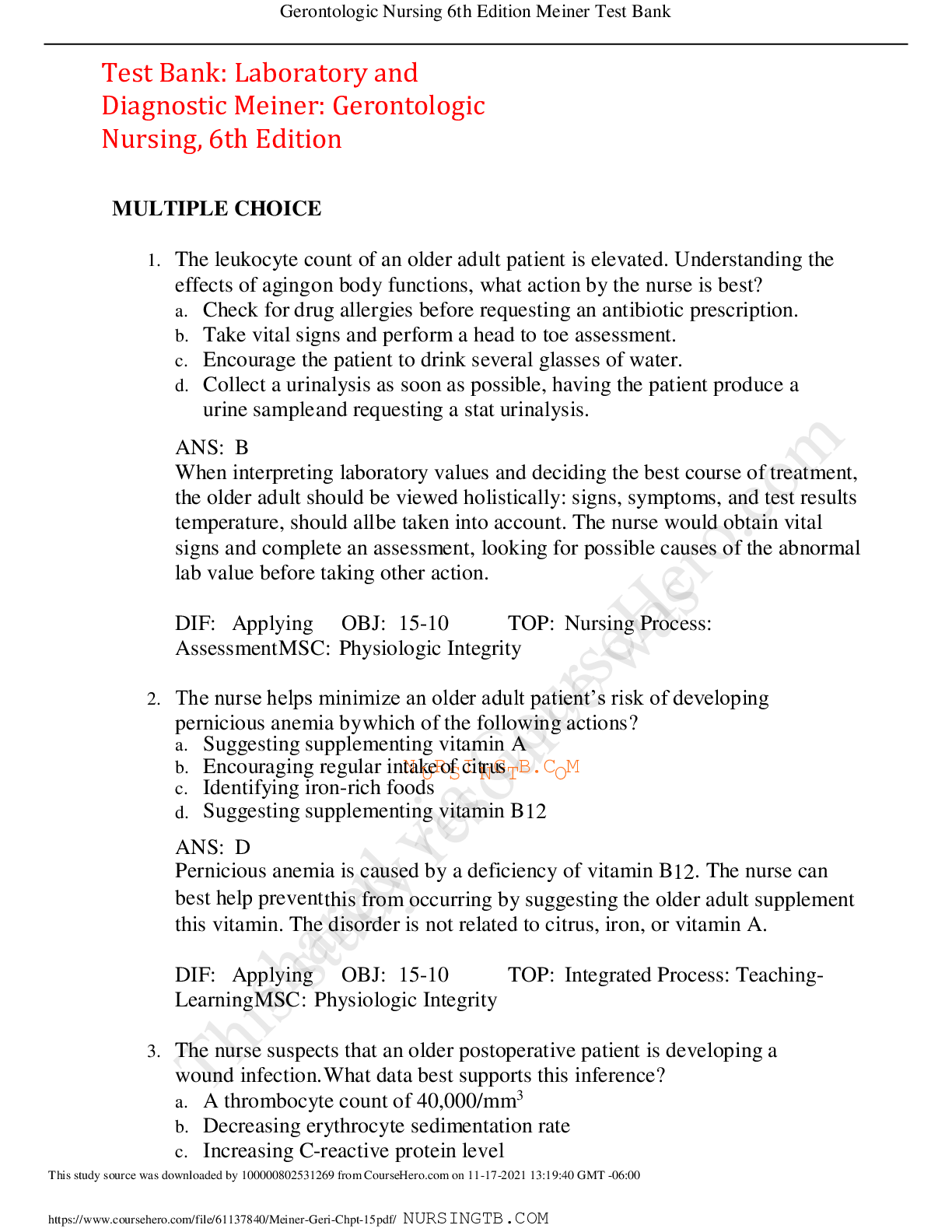
Reviews( 0 )
Document information
Connected school, study & course
About the document
Uploaded On
Nov 17, 2021
Number of pages
14
Written in
Additional information
This document has been written for:
Uploaded
Nov 17, 2021
Downloads
0
Views
46












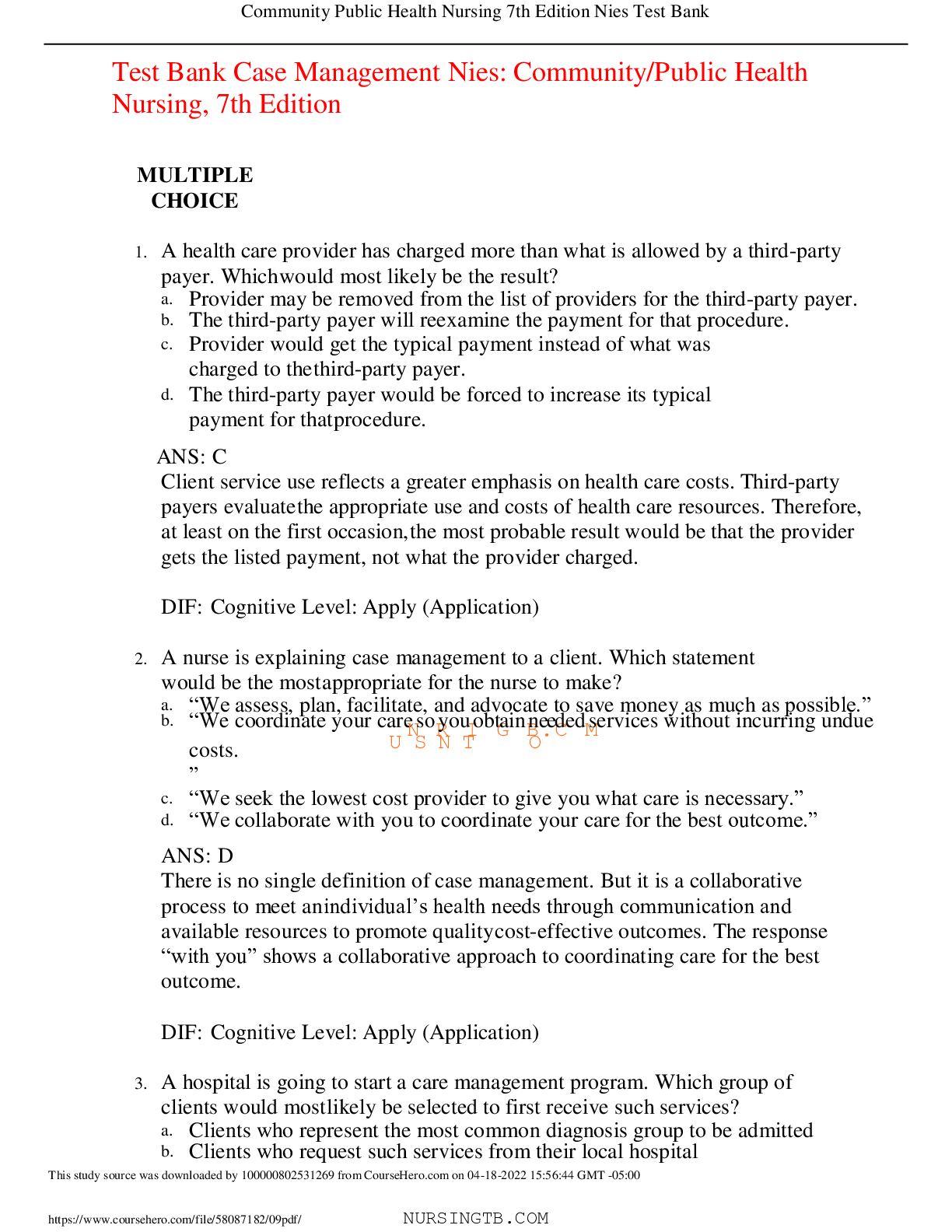


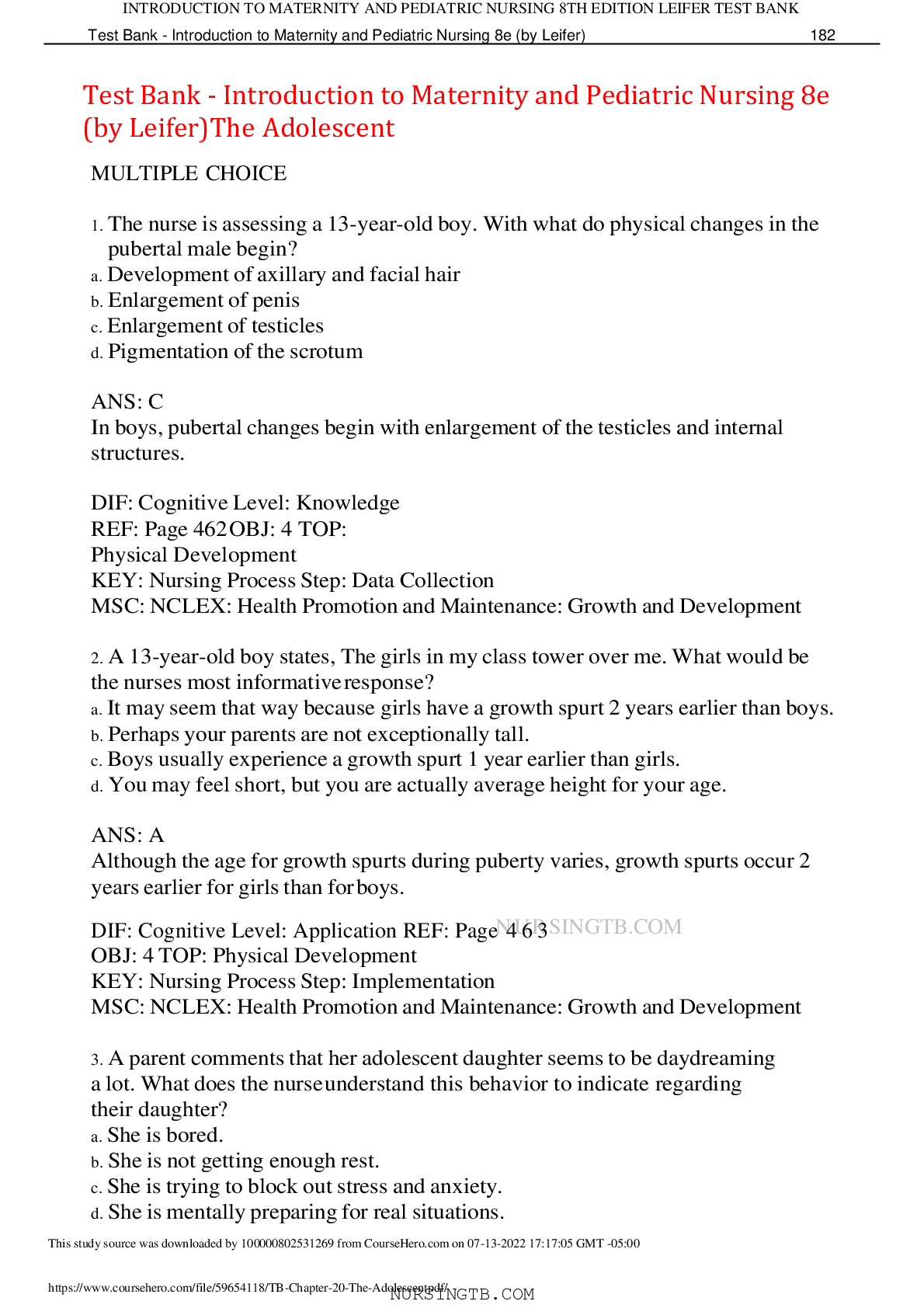

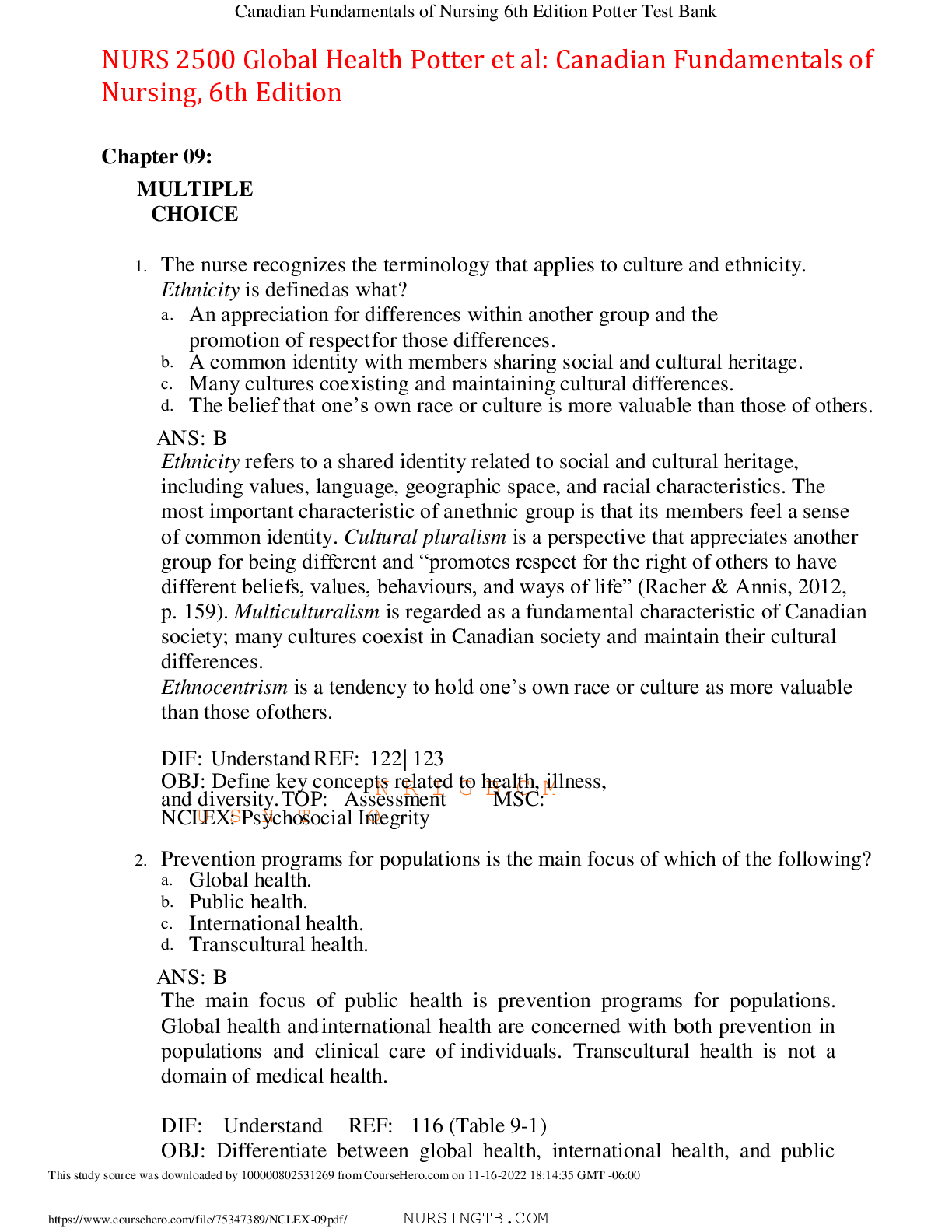

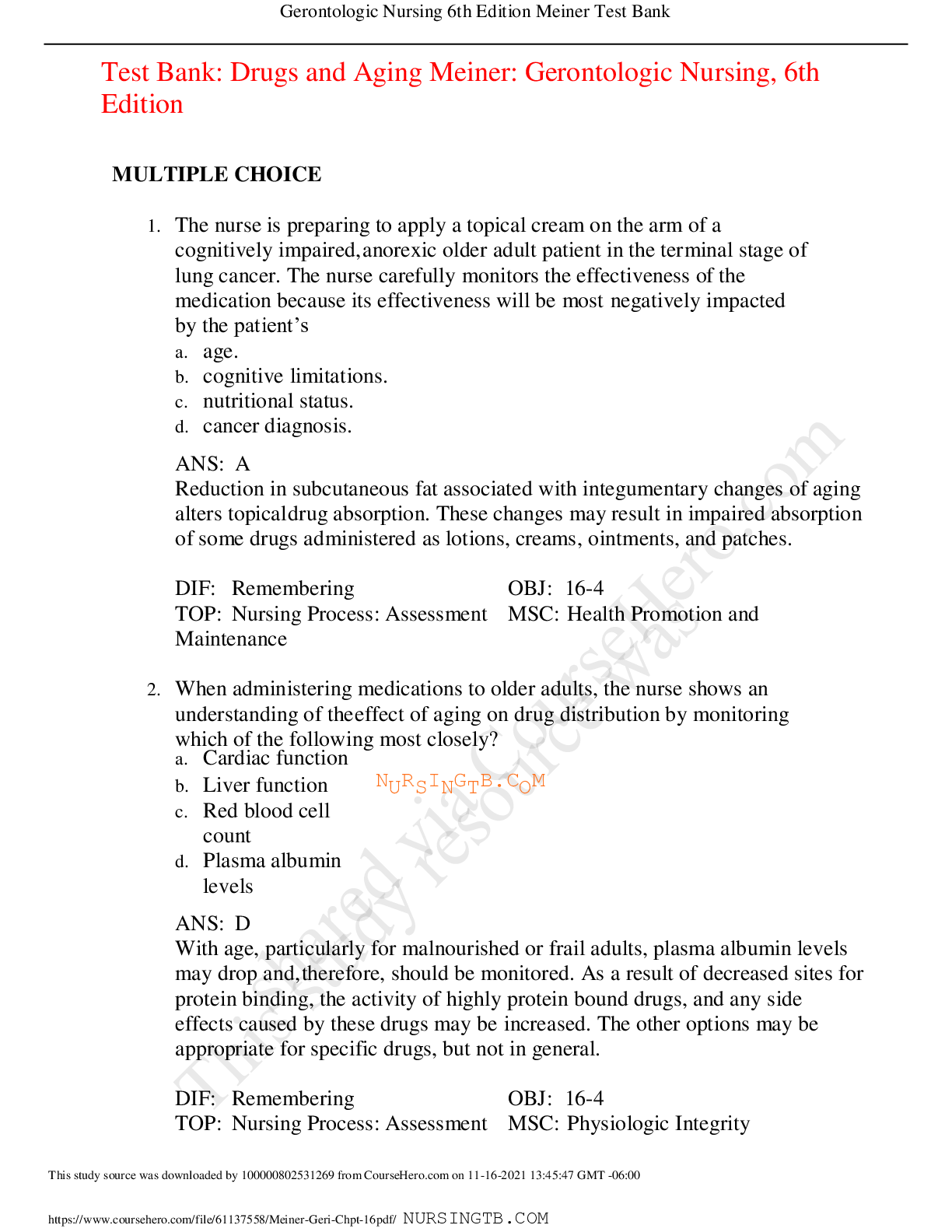




.png)




